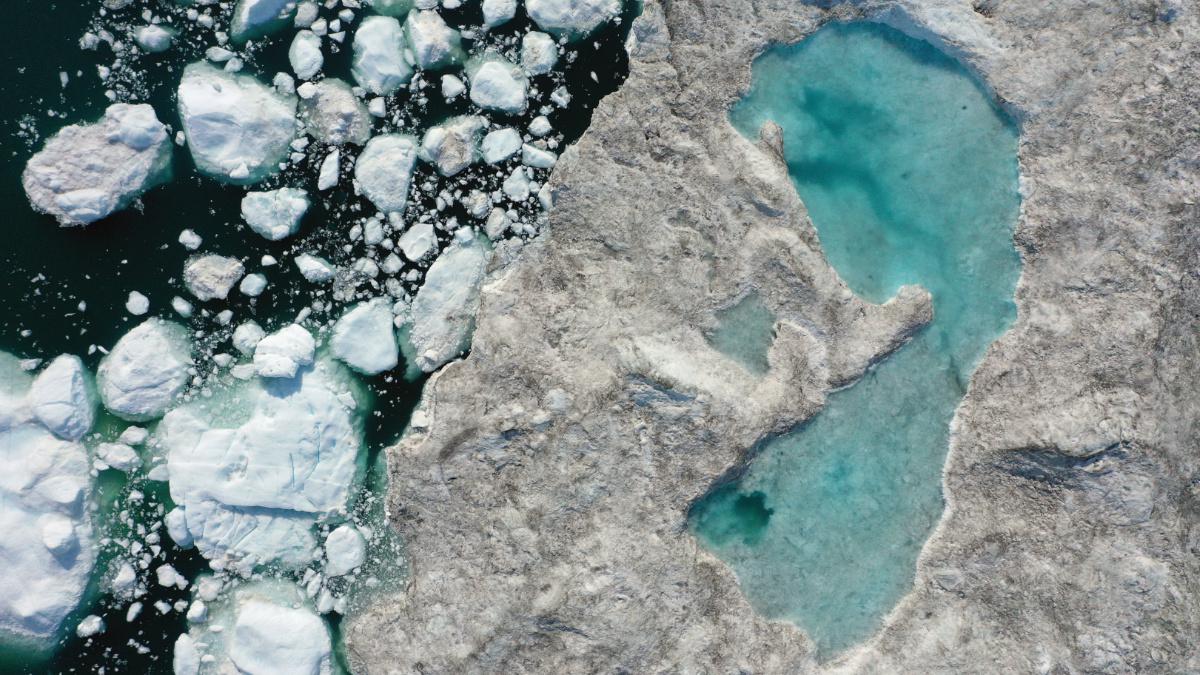

Melting ice forms a lake on free-floating ice jammed into the Ilulissat Icefjord during unseasonably warm weather on July 30, 2019 near Ilulissat, Greenland. Sean Gallup / Getty Images
A first-of-its-kind study has examined the satellite record to see how the climate crisis is impacting all of the planet’s ice.
The answer? Quite a lot. The rate of worldwide ice loss has increased by more than 60 percent in the past three decades, a study published in The Cryosphere on Monday found.
“The ice sheets are now following the worst-case climate warming scenarios set out by the Intergovernmental Panel on Climate Change,” Dr. Thomas Slater, study lead author and research fellow at Leeds’ Center for Polar Observation and Modeling, said in a University of Leeds press release. “Sea-level rise on this scale will have very serious impacts on coastal communities this century.”
Previous studies have used satellite data to assess ice loss from individual sources, such as polar ice caps, The Guardian explained. However, this is the first one to consider all sources of ice loss. The study found that the world lost around 31 trillion U.S. tons between 1994 and 2017. During that time, the rate of ice loss also increased 65 percent, from 0.9 trillion U.S. tons a year to 1.4 trillion U.S. tons a year. Ice loss from ice sheets in Antarctica and Greenland largely contributed to that number, the press release stated.
The paper also broke down which sources had lost the most ice in total terms between 1994 and 2017. Amounts are approximate and in U.S. tons:
- Arctic sea ice: 8.4 trillion
- Antarctic ice shelves: 7.2 trillion
- Mountain glaciers: 6.7 trillion
- Greenland ice sheet: 4.2 trillion
- Antarctic ice sheet: 2.8 trillion
- Southern Ocean sea ice: one trillion
The study also examined the leading cause of ice melt for each source, according to the press release. For Arctic sea ice and mountain glaciers, rising atmospheric temperatures have driven melting. For the Antarctic ice sheet, rising ocean temperatures have been the main cause. And for the Greenland ice sheet and Antarctic ice shelves, melting has been increased by a combination of the two.
All told, melting from Antarctica, Greenland and mountain glaciers have increased sea levels by around 34.6 millimeters, the study found. While this might not sound like a lot, every centimeter of sea level rise puts around a million people in low-lying areas at risk of being flooded out of their homes, the press release said. Moreover, sea level rise isn’t the only threat from melting ice.
“As well as contributing to global mean sea level rise, mountain glaciers are also critical as a freshwater resource for local communities,” Inès Otosaka, report co-author and Leeds PhD researcher, said in the press release. “The retreat of glaciers around the world is therefore of crucial importance at both local and global scales.”
Melting Arctic sea ice is also a problem because it reduces the ice cover that reflects solar energy back into space.
“As the sea ice shrinks, more solar energy is being absorbed by the oceans and atmosphere, causing the Arctic to warm faster than anywhere else on the planet,” Dr. Isobel Lawrence, coauthor and Leeds research fellow, explained in the press release. “Not only is this speeding up sea ice melt, it’s also exacerbating the melting of glaciers and ice sheets which causes sea levels to rise.”
Climate scientist Gavin Schmidt, who was not involved in the study, called it a “thorough accounting of how ice is disappearing from the Arctic, Antarctic and mountain ranges.”
However, he disagreed with the paper’s claim that the melting of floating sea ice does not contribute directly to sea level rise. He pointed to a 2007 paper that found that if all currently floating sea ice were to melt, sea levels would rise around four centimeters. Slater agreed that the language should be changed to make it clear that melting floating sea ice does slightly contribute to sea level rise.
- 'Ghost Forests' Are an Eerie Sign of Sea-Level Rise - EcoWatch
- Sea-Level Rise Takes Business Toll in North Carolina's Outer Banks ...
- Sea Level Rise Is Locked in Even If We Meet Paris Agreement ...

 233k
233k  41k
41k  Subscribe
Subscribe 